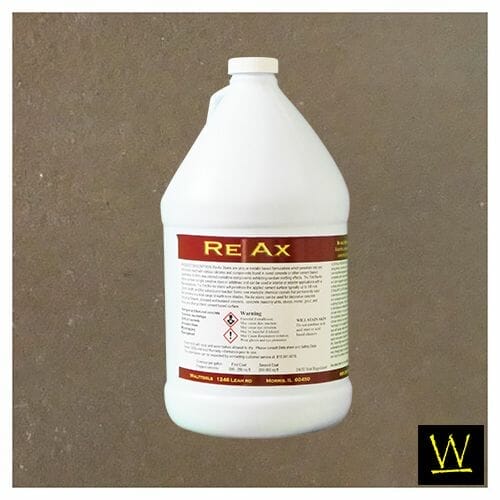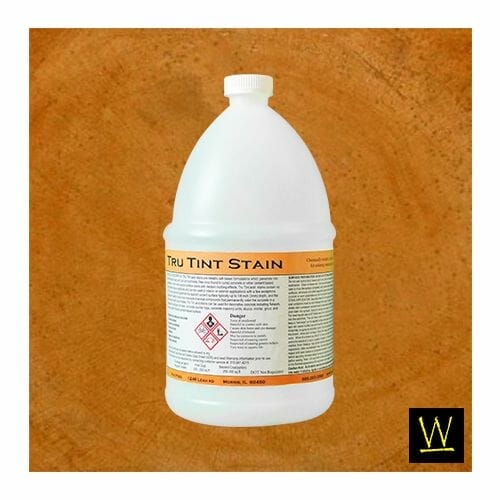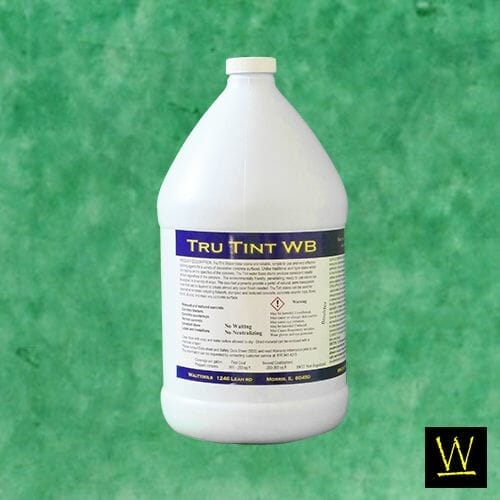
Let’s break down the concrete coloring options one by one.
———
Integral Color
Integral color is probably the most basic and simple way to color concrete. To use integral color, you just put the pigment powder bags into the red-mix truck (or whatever container it’s being mixed in) and make sure it is thoroughly blended with the concrete. When the concrete slab is poured it will have a nice uniform, monochrome, traditional look. It colors all the way through the concrete which makes chips less noticeable, so it is a good choice for high-traffic areas where the ground is more likely to get chipped.
Color Hardener // Dry Shake
Color hardener, also called dry-shake, will provide a similar look to that of integrally colored concrete, except that it is used after the concrete is poured and is being finished. The installer broadcasts this specialized color pigment cement blend onto the wet surface and works it in, usually through bull-floating, giving color to the top layer of concrete. Since it is not colored all the way through, it is usually less expensive but deeper chips will be more noticeable. Color hardener fortifies the surface, thus the name. It makes the surface more resistant to moisture and de-icing salts. Since the color sits on the top of the slab, grinding or polishing the concrete is not an option because the colors would be removed.
Note: This coloring method is also very messy. Everything surrounding the area to be colored must be shielded from the pigment.
Colored Release (Accent Release)
When concrete stamping with texture tools, a release agent must be used to prevent the tools from sticking to and pulling on the fresh concrete surface. Traditional powder release agents are colored so that they provide a contrasting color, providing an “antique” look. Although it’s considered a “messy” product, that contrasting look really contributes to the decorative aspect of stamped concrete. Liquid release is another option and is normally clear. This is often used when the installer plans to stain the concrete after the pour or must avoid the mess that of powder release. Some installers go a step further and blend a small amount of the powder release into the liquid release to add some color toning as they texture. This method of coloring can be used in conjunction with integrally colored or color hardened concrete.
Antiquing Agent (Tru Tique)
A less messy alternative for the antique aesthetic of colored accent release is Tru Tique. It is an antiquing agent that mimics the look of powder release. It is a colored powder pigment mixture that is added to water, liberally applied to the plain textured surface, and then spread around with a broom or brush. The specialized pigment settles into the low textures and is allowed to dry. The dried look is very close to the antique look done with powder release, but without the mess. This can be used with integrally colored or color hardened concrete as well.
Stain (Acid, Water-Based, Re-Ax Reactive)
Stain is a general term for any sort of liquid that is applied topically to the surface and leaves color. Stains are either reactive or non-reactive and will have different abilities to color depending on the makeup of that surface. Rough, smooth, indoor, outdoor, etc. factors all play a roll in concrete staining.
Stains can be used on new or existing concrete AND they can be added on top of integrally colored or concrete colored with hardener.
For the longest time, decorative concrete contractors have been using acid based chemical concrete stains, or simply, acid stain, to achieve rich, earth-toned color schemes resembling natural stone, marble, wood, or even leather. But today, contractors are no longer limited to earthy shades. Acid stains are created with a blend of acid, metallic salts, and water. The acid chemically reacts with the minerals within the concrete and the reaction creates a beautiful mottled surface effect.
Once stained, you will have to fully neutralize and clean the surface with a suitable concrete cleaner before applying your protective concrete sealer. They are classified as a concrete reactive stain. Concrete acid stains become a permanent part of the concrete. They’re known for their durability and long-lasting color because cement stains will not fade, chip, or peel off. The color pallet is a bit limited but Walttools has the largest color range available. Concrete acid stains are known for their translucent color and ability to react differently creating one-of-a-kind color and patterning. These stains will require the user to take safety precautions, as the user is working with acid.
Water-based stains are greatly expanding the installer’s palette with colors ranging from soft pastels to rich reds, oranges, yellows, and purples. In most cases, these newer stain products can be easier and safer to apply.
If you want to go beyond the drama and more limited color palette of reactive staining, consider using water-based stains. With Walttools offering 40 stock colors and custom blending available, they are and extremely popular choice for contractor and DIYer alike. Color is more consistent between surfaces and there are no harsh chemicals involved. Colors can be diluted, combined, layered, and manipulated in many ways to achieve the desired effects. Water-based concrete stains are suspensions of micro-fine or nano-pigments suspended in a water-based solution of penetrating and binding agents. Because pigment color choices are so plentiful there is a wider color variety to choose from. A good water-based stain will give you time to work with it yet be permanent when cured out. Water-based stains work by actually flowing into and filling the concrete pores and bonding into the surface. Because they are more surface dependent for soaking in, you need to be sure proper prep is done to open up the surface to allow for a good, deep bond in the pores. C-Etch is a great product for that by safely etching the surface giving you plenty of porosity.
As shown at the top of the page, Re-Ax Stain, exclusive to Walttools, is similar to acid stains in that it chemically reacts with the concrete surface, but different in that it does so without the extra work involved with acid stain cleanup. These are simply “apply, wait for the color change, and then seal” stains. They are especially potent in their ability to mottle the surface to produce the most variation of any concrete stain. As with acid stains, they will potentially react different on each concrete slab, so the chosen stain should always be tested for color reactivity before proceeding.
Simply spray on the Re-Ax, work it in with a broom (optional), wait a few hours for the color change, and then seal it up. You could not have an easier process and, once again, there is no need to neutralize the surface like you must with acid stains. They are best for creating the “Old World” look on your project.
Concrete Dyes are very deep-penetrating colored solutions that are mostly used indoors and/or on very hard or polished concrete surfaces that are more difficult to penetrate with water-based stains. They are quite popular when doing concrete countertops because they can be polished after application without removing much color.
Dyes are definitely the most vibrant option. They are the best choice for creating bold graphics. However, they are not UV-stable, so they’re bad for outdoor use. The sun will fade the colors pretty quickly.
———



